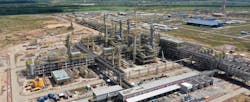Petrobras lets contract for Route 3 presalt gas plant
Petróleo Brasileiro SA (Petrobras) has let a contract to TS Participações e Investimentos SA subsidiary Toyo Setal Empreendimentos Ltda. to complete a new natural gas processing unit (UPGN) already under construction at the Polo GasLub Itaboraí hub in Itaborai, Rio de Janeiro, Brazil, as part of the operator’s Route 3 integrated project to expand transportation and processing of associated gas from the country’s offshore Santos basin presalt (OGJ, Nov. 7, 2022, p. 40).
As part of the Mar. 24 contract, Toyo Setal will conclude construction of the UPGN, which halted in midyear-2022 following the previous main contractor’s inability to complete the project, Petrobras said.
Award of the contract follows Petrobras’ launch of a tender in September 2022 seeking a replacement contractor to complete the remaining scope of work on the Route 3 UPGN. The tender, which closed in mid-November 2022, called for the winning bidder to deliver civil construction, electromechanical assembly, interconnections, commissioning, pre-operational and start-up services, as well as assisted operation of lingering works for both gas processing units of the GasLub Itaboraí complex’s Route 3 gas plant, including supply of materials and equipment.
With the newly awarded contract to Toyo Setal, Petrobras said it expects start of gas processing operations in the GasLub Itaboraí to begin in 2024 in accordance with the operator’s 2023-27 strategic plan.
Other units required to start these operations—including auxiliary units as well as subsea and onshore pipelines—have already completed construction and are in their final commissioning or preoperational phases, Petrobras confirmed.
Route 3 project overview
Part of the Petrobras’ repositioning plan for its cancelled Comperj integrated refining project—renamed as GasLub Itaboraí in 2020—the Route 3 combined gas pipeline-UPGN project’s integration with the previously completed Route 1 and Route 2 pipeline projects aims to increase the operator’s presalt gas offloading and processing capacity to 44 million cu m/day from 23 million cu m/day (OGJ Online, Dec. 23, 2019).
Alongside the new Route 3 UPGN—which will consist of two 10.5-million cu m/day processing trains—the Route 3 project includes a 355-km gas pipeline (307 km offshore, 48 km onshore) that will deliver about 18 million cu m/day of natural gas from the Santos basin presalt cluster to the UPGN at GasLub Itaboraí.
By providing an outlet for associated gas from the Santos basin presalt area, Petrobras said it expects completion of the Route 3 project also will enable increased production of crude oil from the presalt offshore fields.
Project progress
Before the halt to construction activities for the Route 3 UPGN, a series of major works on the new gas plant and associated pipeline system had already been completed.
In a series of Petrobras Informas regional updates issued between October 2019 and February 2022, the company confirmed concluding the following construction-related activities on the Route 3 UPGN and gas pipeline:
- Installation of the UPGN’s first six processing towers in February 2020, which was to be followed by installation of the plant’s second and final batch of seven processing towers in May 2020.
- Achieving 50% of the UPGN’s physical construction by yearend 2019, including laying of foundations, bases, drainage, and paving, in addition to advanced assembly of about 3,000 tonnes of piping and 2,000 tonnes of metallic structures and other unidentified electromechanical equipment.
- Installation by October 2019 of the UPGN’s 156-m high flare tower and associated equipment to disperse gases and heat produced during processing operations. The flare tower consists of two burners: one with a maximum relief flow of up to 1,400 tonnes/hr for burning hydrocarbon gases, and another equipped to burn acid gases at a rate of up to 240 tonnes/hr.
- Assembly and installation of GasLub Itaboraí’s air-cooling system to prevent overheating of the UPGN’s equipment from heat generated by the site’s associated electrical system.
- Delivery of other major equipment by yearend 2019, including the onshore complex’s prefabricated electrical system.
In late-January 2022, following initial work stoppage at the site, Petrobras began preliminary operational tests at GasLub Itaboraí with reception of unprocessed gas (rich gas) volumes from the Cabiúnas terminal via the Guapimirim-Comperj I (Gaserj) gas pipeline, the operator said in a mid-February 2022 release. The gas enabled startup of GasLub Itaboraí’s utility systems—mainly the steam generation and distribution unit—to guarantee operation of installations and equipment necessary for full startup of the new UPGN.
The site’s water treatment plant, substations responsible for energy distribution—including electricity—an integrated control center, auxiliary utilities systems, and the flare system also were already operating, Petrobras said.
Petrobras—which completed installation of the deepwater sections of the Route 3 pipeline in 2019, and shallow-water and onshore sections in early 2022—began partial operation of the pipeline’s ultradeep and deep maritime sections in June 2022 with an undisclosed volume of pre-salt natural gas deliveries from the P-77 platform in Santos basin presalt layer’s Búzios field. At the time, natural gas flows through the operable Route 3 portion of the line were directed via an interconnection to the Route 2 gas pipeline for delivery to the 24.6-million cu m/day Cabiúnas gas processing plant in Macaé, Rio de Janeiro.
Petrobras previously said it also was continuing to evaluate integration of some units at GasLub Itaboraí with its 239,000-b/d Duque de Caxias (REDUC) refinery in the Baixada Fluminense area of Brazil’s Rio de Janeiro state for production of basic lubricants and fuels from intermediate products delivered via pipeline from the refinery to the Itaboraí gas hub.

Robert Brelsford | Downstream Editor
Robert Brelsford joined Oil & Gas Journal in October 2013 as downstream technology editor after 8 years as a crude oil price and news reporter on spot crude transactions at the US Gulf Coast, West Coast, Canadian, and Latin American markets. He holds a BA (2000) in English from Rice University and an MS (2003) in education and social policy from Northwestern University.

